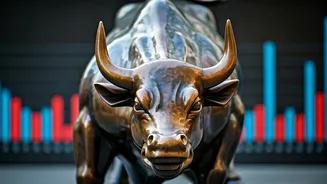Gold's Recent Performance
The price of gold has demonstrated remarkable stability, hovering near previously established record highs. This stability is particularly noteworthy considering
the evolving landscape of global trade, especially the reduced tensions between the United States and China. Historically, these trade conflicts have often fueled the demand for gold as a safe-haven asset, but even with this specific area of concern lessening, the metal's value has been holding firm. This suggests there are other underlying elements which are currently contributing to the bullion's strength. These might include various concerns related to the global economy and also investors’ overall sentiments. The unwavering performance of gold, even as other financial markets undergo fluctuations, highlights its enduring role in investment strategies across the world. Furthermore, it showcases the multifaceted nature of the factors which influence its price movements, extending beyond just the singular influence of international trade disputes.
Safe-Haven Demand Factors
One of the primary drivers supporting gold's value is its well-established status as a safe-haven asset. During periods of economic uncertainty or geopolitical instability, investors often turn to gold as a means of preserving their wealth. This demand can arise from several sources. Market volatility, brought on by things such as concerns about global growth or financial market disruptions, can drive investments in gold. Additionally, uncertainties regarding inflation and currency devaluations often prompt investors to seek the perceived security that gold provides. Furthermore, geopolitical events, such as international conflicts or domestic political instability, tend to amplify this 'flight to safety'. The widespread desire for a secure store of value, particularly when other investment options appear risky, bolsters gold's price. Its perceived value isn't dependent on any particular government or institution.
Trade Tensions' Impact
The lessening of trade tensions between the United States and China is a significant development, but its impact on gold's price has been less pronounced than expected. Traditionally, trade conflicts can lead to economic instability, prompting investors to seek safe-haven assets like gold. The current situation suggests that other variables are at play, overshadowing the effect of the easing tensions. This could be due to other prevailing concerns, such as low-interest rates or rising inflation expectations, which may be more influential than trade-related concerns in shaping market sentiment. Additionally, investors may have already factored in a degree of resolution in trade disputes. Furthermore, the overall sentiment in the market, including broader economic forecasts and views on future developments, has likely played a role in gold's enduring value. The complex interplay of multiple factors currently impacts gold's valuation.
Market Sentiment Matters
Market sentiment, the overall mood or attitude of investors towards a specific market or asset, has a crucial effect on gold prices. Positive market sentiment towards gold can drive demand, which in turn leads to price increases. This sentiment can be influenced by several factors, including positive economic data, increased risk aversion, or expectations of future inflation. For instance, when investors are optimistic about economic prospects, they may shift their investment strategies towards perceived safe assets. This is in contrast to negative sentiment that can cause selling pressure and push prices down. Moreover, external factors, such as central bank policies, and global economic growth forecasts influence investor behavior. Therefore, understanding and monitoring market sentiment is essential for comprehending gold’s price movements and adapting investment strategies accordingly. Investor confidence and perception of value are significant drivers in the market.
Economic Indicators' Influence
Various economic indicators play an important role in influencing gold prices. Inflation rates are a crucial factor, because gold is often seen as a hedge against inflation. Therefore, when inflation is expected to rise, investors may buy gold to protect their purchasing power, driving its price upwards. Interest rates also influence gold’s attractiveness. Low or negative real interest rates (where inflation exceeds interest rates) make gold more attractive compared to other interest-bearing assets. Moreover, the strength of the US dollar also impacts gold prices. Since gold is typically priced in US dollars, a weakening dollar often makes gold cheaper for buyers using other currencies, boosting demand and prices. Economic growth data, such as GDP figures and employment statistics, can also affect investor sentiment and, therefore, gold prices. Economic uncertainty or recessionary fears tend to boost gold's appeal as a safe haven.
Geopolitical Developments' Effect
Geopolitical events can significantly influence gold prices. International conflicts, political instability, and other global tensions often lead to increased demand for safe-haven assets like gold. During times of war or heightened geopolitical risk, investors often flock to gold to safeguard their capital from potential losses. Political uncertainties, such as elections or changes in government policies, can also lead to market volatility and boost gold prices. Furthermore, events that impact global trade, international relations, or the stability of financial markets tend to affect investment decisions, driving demand for safe-haven assets. Consequently, understanding the impact of these events is essential for investors looking to make informed decisions in the gold market. The perceived stability and security offered by gold during uncertain times make it an attractive investment during heightened geopolitical risks.
Future Outlook for Gold
Predicting the future of gold prices involves considering multiple factors, including economic, political, and market-related aspects. The prevailing economic landscape, including inflation rates, interest rates, and global growth forecasts, will be crucial. Expectations of rising inflation often encourage investors to invest in gold as a hedge, potentially driving prices up. Central bank policies, especially decisions related to interest rates and quantitative easing, will also affect gold’s attractiveness. Geopolitical developments, such as international conflicts and political instability, will continue to play a role by influencing investor sentiment. Additionally, market sentiment will contribute. The overall attitude of investors, shaped by various factors, will influence the demand for gold. Therefore, a comprehensive assessment of all these factors is necessary for forecasting the future trajectory of gold prices and making well-informed investment choices.
















